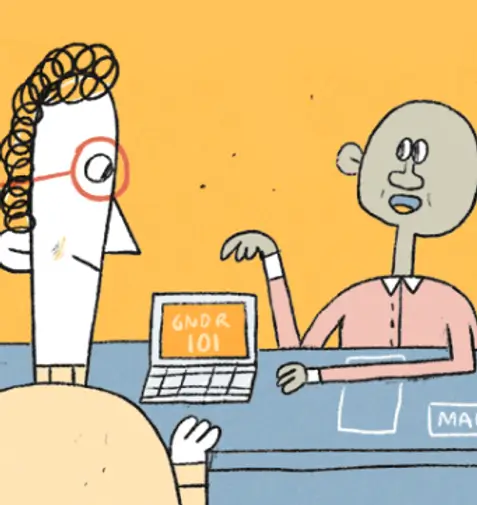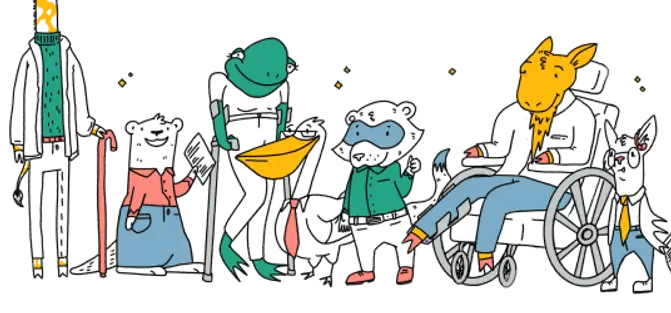Diversity, Equity, and Inclusion
Diversity, Equity, and Inclusion all mean different things, and if you’re serious about making a difference in your workplace, you’ll want to get these right:
Diversity
Diversity is a specific way to frame or embody the makeup of a group of people. This word is often used (fallaciously) to refer to a specific person, or hire (e.g. “our new Head of People is diverse”). In one group of people, we’ll likely have as many, if not more, differences (age, race, gender identity, educational background, etc.) than we do similarities. These differences–this diversity–is what makes our lives with one another so vibrant, exciting, and a lifelong learning experience. It’s important to have and acknowledge diversity in the workplace for this very reason.
Equity
Equity is explicitly about leveling the playing field, so everyone has a fair chance at opportunity. Following Diversity, Equity speaks to the fairness of a group of people when it comes to access in the world. In any diverse group of people (i.e. most groups of people), the differences between each person in the group have different impacts on the way each person views and moves throughout the world. For example, someone without a car might need access to a bike lane or public transportation in order to get to work alongside their car-owning colleagues. An equitable employer might offer discounted or tax-free public transportation fare for their employees to ease everyone's morning commute.
Inclusion
Inclusion is the principle that everyone deserves to have a sense of belonging, to feel valued, and most of all, to be respected. Inclusion speaks to the feeling of belonging that an individual has in society (and in the spaces where they socialize and work). Just because an organization is diverse doesn’t mean that it’s automatically inclusive. A company may hire far more women than men, for example, but women at the company may not feel included, valued, or respected due to things like gendered pay disparity, a lack of senior leadership representation, or other factors.
Related Terms and Definitions
Identity
Identity is a complex idea, and it has a lot to do with the way we define ourselves in relation to others. In workspaces, we can often think of identity as a mix of the protected classes by law: race, religion, sex, national origin, disability status, and age, to name a few. And even many aspects beyond explicit discrimination law, like educational or economic background, for example. The important thing is that making everyone feel included means engaging with others’ identities with respect.
Intersectionality
Intersectionality is the idea that various parts of our social identities, such as race, age, gender, sexual orientation, and religion converge to shape who we are and how we are treated. This framework was originally coined by Kimberlé Crenshaw, who formulated this concept to address the experiences of Black women and the importance of antiracist and feminist work.
Bias
Bias is when a person has an inclination toward or away from a person, place, thing, idea, or group, usually based on upbringing and experiences. When it comes to making workplace decisions (like hiring, promoting, assigning, etc.) bias like this can have huge ramifications for individuals, companies, and processes.
Implicit vs. Explicit Bias: What's the Difference?
Implicit vs. Explicit Bias: When someone is aware of their internal biases and attitudes toward a person or group of people and conducts themselves with strong, bias-formed intentions, they’re acting with explicit bias. In the worst examples of explicit bias, we would recognize this behavior as discrimination and harassment.
Implicit Bias
Implicit Bias is an inclination to make assumptions about other people based on your own, internalized stereotypes, typically without being aware of these assumptions. Implicit Bias is also sometimes referred to as “unconscious bias."
Rising Identities
Rising Identities are the identities of individuals who have been marginalized or actively omitted from systemic consideration in the past. This is a term we picked up from reading Stephanie Pinder-Amaker and Lauren Wadsworth’s book, Did That Just Happen?!.
Bystander Intervention
Bystander Intervention is when someone steps in to help a colleague experiencing discrimination or harassment. A healthy, DEI-focused workplace should encourage colleagues to stand up for one another when witnessing harassment rather than stepping away. And there are many ways to do so.

Cultural Awareness?
A lightning round of some “culture” terms that you’ve likely seen before but might have confused with something else.
Cultural Competence
Cultural Competence is the ability to recognize and understand one’s own culture and the willingness to learn, accept, and respect the cultural differences of others in the world. Because our world is so diverse–and constantly growing and changing–cultural competency is a lifelong learning journey. Cultural competence is a training concept used more frequently in professional spaces that work directly with other people, like medicine, human services, and education, to name a few.
Cultural Awareness
Cultural Awareness is the ability to recognize cultural differences in one’s self and others, especially as it relates to equity, inclusion, and bias in daily life. Sometimes called “Cultural Sensitivity,” cultural awareness is the key element of cultural competence: the ability to recognize cultural differences in one’s self and others, especially as it relates to equity, inclusion, and bias in daily life.
Cultural Diversity
Cultural Diversity occurs within a system or place that recognizes and respects the entire diversity of groups within society, validates and values their cultural differences, and advocates and supports the continued contributions of all cultures for the betterment of us all.

Why You Need a DEI Program
There are many reasons why any organization or group of people could benefit from an ongoing DEI program. Diverse and inclusive teams are far likelier to perform better, innovate more, make faster informed decisions, and be overall more productive. And companies that invest in DEI are more productive overall.
According to research...
35%
took longer to complete their work than they could have due to racial bias
45%
of workers put less effort into their work afterward after experiencing racial bias at work
It's the Right Thing to Do

Profits and employee retention margins aside, a living, breathing DEI program won’t survive unless the entire company, from the top down, believes in the importance of DEI work and the truth behind the program. When we invest real time, money, and work into making the workplace better for one another, we prove to one another that we genuinely care about making a positive difference in their daily lives. It’s just the right thing to do.







